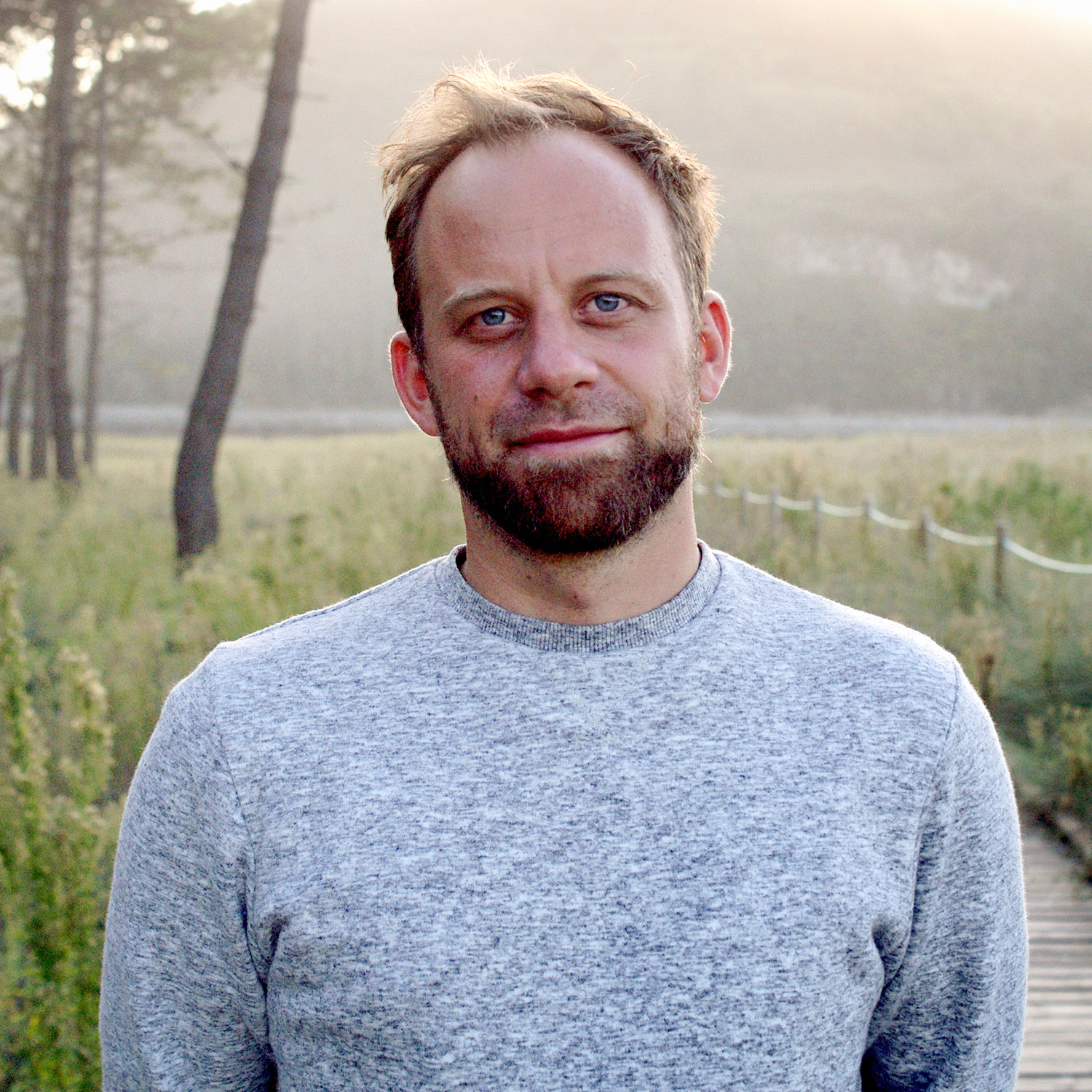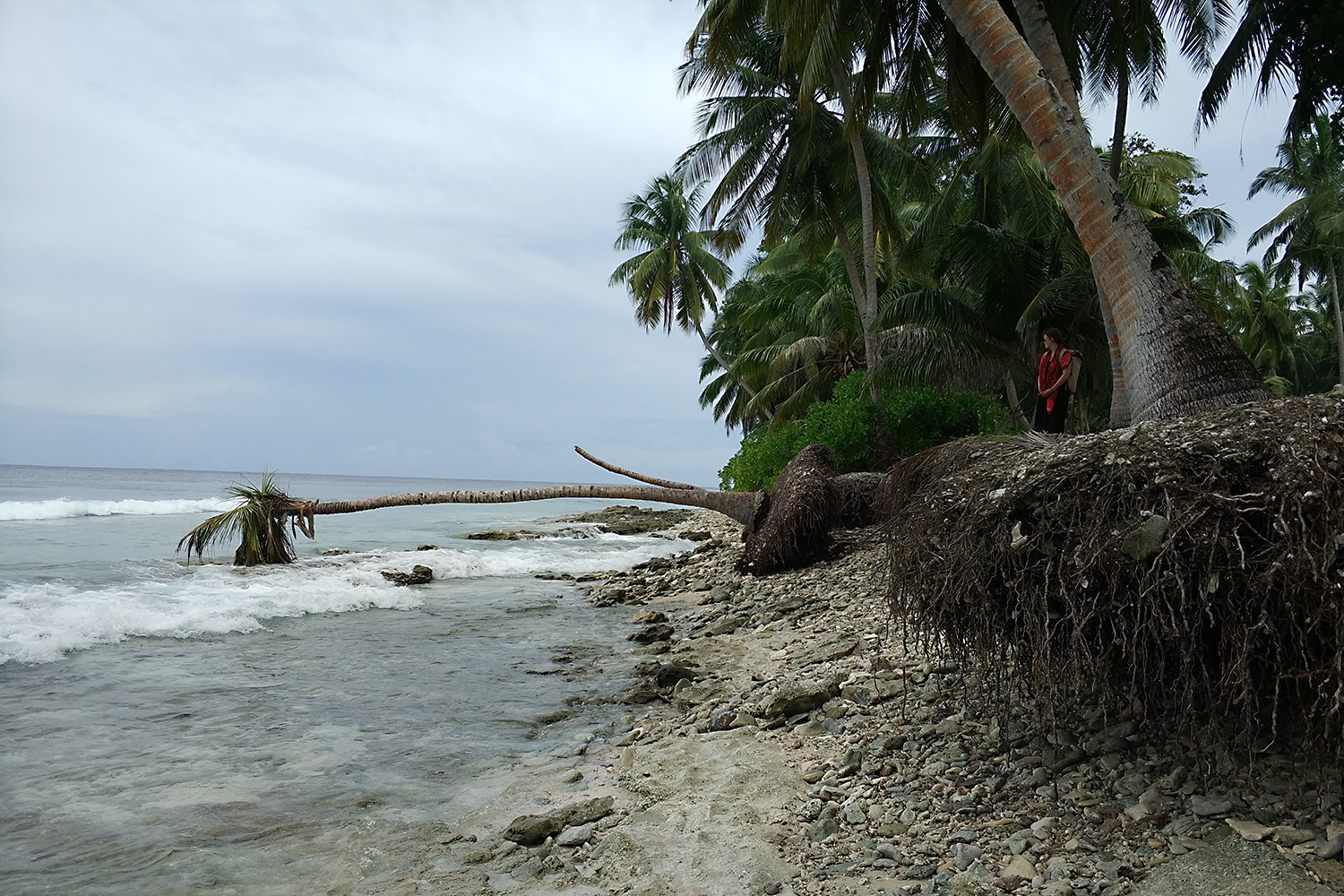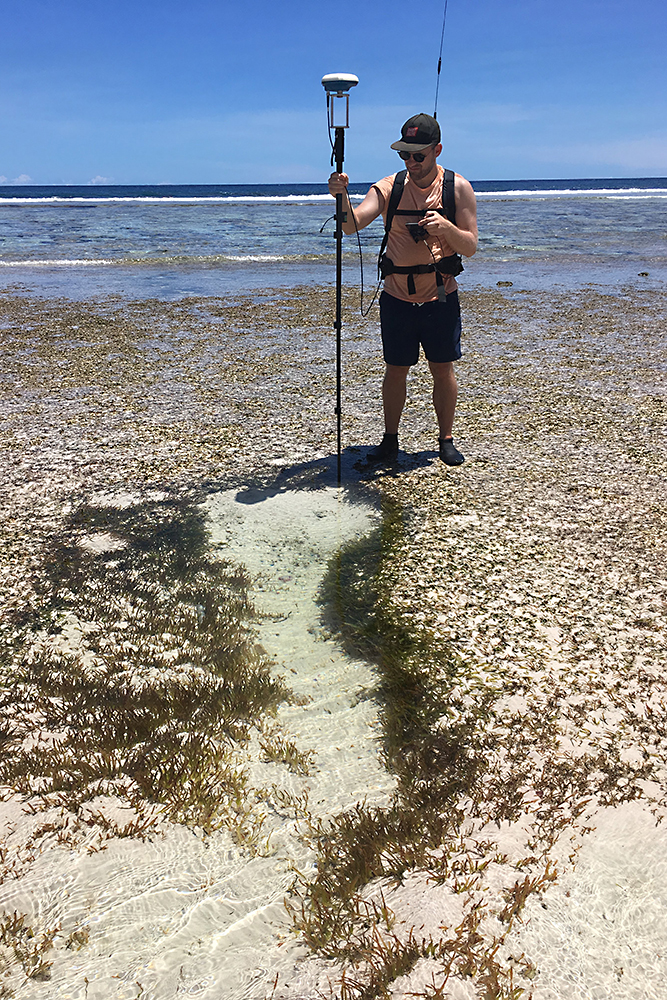The Future of the Urban Coastline Gabriel David on the new Junior Research Group "Future Urban Coastlines".
Rising sea levels, storm surges, flooding – what does climate change mean for our coasts and cities? The new Junior Research Group “Future Urban Coastlines” investigates the dangers urban areas on the coasts are exposed to and develops approaches for adapting to climate change and protecting the coasts. Bianca Loschinsky spoke with Dr.-Ing. Gabriel David, the head of the interdisciplinary Junior Research Group, about the future of urban coastlines.

Gabriel David surveying with a drone on Fuvahmulah Island. Picture credits: Gabriel David/TU Braunschweig
Mr David, you have been leading the new Junior Research Group (JRG) “Future Urban Coastlines” since August 2021. Which urban coastlines do you have in mind here?
First of all, we look at what is closest, for example towards the North Sea. We, the Leichtweiß-Institute for Hydraulic Engineering and Water Resources (LWI), already have various projects in the more rural area of the North Sea coasts, so that we can build on previous findings in ecosystem-based coastal protection. The task of our Junior Research Group is, among other things, to transfer these results to more densely populated, urban areas – that is, to communities where there is a lack of space, where you can’t offer the natural dynamics the space and freedom more nature-based solutions would actually need.
In Hamburg, there are various initiatives dealing with the Elbe, but of course the island communities of the North Sea are also interesting. Hopefully, in the near future, we will be able to embed the research of the Junior Research Group in an international context. I have a particular interest in that: I wrote my dissertation mainly on small island states in the global south, with a focus on the Maldives, which is a very densely populated area.
What will the Junior Research Group specifically scrutinize?

Gabriel David is the head of the Junior Research Group “Future Urban Coastlines”. Picture credits: Gabriel David/TU Braunschweig
Basically, it’s about offering measures for coastal protection that integrate better in the coastal environment and using materials that support the coastal habitat while protecting the inhabitants. A kind of renaturation of areas that are currently still very technical. Keywords here are “Animal-Aided Design” or “Biodiversity Sensitive Urban Design”. On the one hand, this means creating habitats for certain species that also meet engineering requirements. If this is not possible, we try to think about the permeability of measures for certain species, which are not going to separate or interrupt habitats.
In the long term, we want to focus further in the direction of spatial planning and bridge the gap between faculties. I see the Junior Research Group quite clearly as an interdisciplinary research group working within the university’s research focus “Future City”, which also connects to, for example, social sciences and is oriented towards the Sustainable Development Goals of the United Nations or the Ocean Decade.
Which different disciplines do the scientists of the Junior Research Group come from?
The Junior Research Group is a joint initiative of Professor Nils Goseberg, Professor Boris Schröder-Esselbach and Professor Harald Kloft, so we initially have the fields of coastal engineering, geoecology, architecture and civil engineering.
There are already various interdisciplinary projects at the LWI, such as “Gute Küste” or BIVA-WATT. Here, scientists are investigating, for example, effects of the oyster population in the North Sea on coastal protection. We will initially support these two projects with the JRG, but of course we will also set our own accents within the framework of “Future City”.
What does the future of urban coasts look like? What dangers are they exposed to?
One danger is, of course, sea-level rise. Sea-level is the hydrostatic load that acts on the structure. But there are other cascading effects: When the water level rises, the water depth increases and the waves break later, i.e. closer to the structure. And thus the hydrodynamic load on the structure is also higher. It is virtually certain that the sea level rises and continues to rise. What is not yet entirely clear is whether storm frequency and intensity will increase, which in turn would lead to stronger waves.
What action needs to be taken now?
Sea levels have been relatively constant for 2,000 years. But today we know that sea levels began to rise relatively strongly and suddenly. But we cannot quantify sea level rise for the next century. When building infrastructure as civil engineers, we have to prove that the structure will reach a certain age despite facing characteristic loads and impacts. This is the so-called design lifetime. Against the background of uncertain forecasts and climate change projections, however, we cannot rely on the fact that structures will be able to provide the planned protection or withstand the increased loads in the next 100 years. This is because we cannot yet predict the water levels at the end of the century.
In research, there are now approaches such as “robust decision making” or “dynamic adaptation pathways”. This is an attempt to act more flexibely, i.e. to adapt step by step with smaller measures instead of, for example, building a dike being able to withstand sea-level rise of 1 to 1.50 metres. At the same time we can follow and implement technological advances, while monitoring the current effects of climate change and those of a near, predictable future.
This principle has already been applied to the so-called climate dikes in Schleswig-Holstein. The new dike height consideres one of the projected future sea levels. But additionally, the structural design of the dike contains additional potential to raise the dike further. This is such an adaptive approach: we are dealing with the challenges of today and the near future but do not impair future adaptation to higher than expected sea levels.
And of course this coastal protection should be as sustainable and nature-based as possible. Our Junior Research Group “Future Urban Coastlines” does not aim at “greener” protection, but we want coastal adaptation to benefit, or at least integrate into the coastal ecosystem.
Where might new urban coasts be built in 10 to 20 years?
Berlin at the sea – that’s a popular Hollywood scenario. The latest IPCC report (Sixth Assessment Report of the Intergovernmental Panel on Climate Change) projects sea levels to rise between one to over 1.50 metres in the worst case. Areas that lie below sea level (such as the Netherlands) can then be flooded if the adaptation measures no longer work and the dikes or technical structures are damaged. One metre to 1.50 metres is roughly the difference between normal water level and high tide. What is now the high water level on the North Sea will then be the mean sea level. Then, of course, the high tide would be added onto the higher mean sea level. This will certainly not shift the coastline to the Berlin city limits, but in coastal regions the differences will not only be noticed by humans, but especially by the coastal ecosystems.
Nevertheless, my feeling is that in the end we are still assessing many things too positively, for example because there are things we cannot foresee yet, such as tipping points or certain factors in our climate models. This makes it all the more important to develop and apply new technologies and processes for coastal protection so that we are able to react appropriately to uncertain predictions. For example, automated 3D printing processes and the associated digital manufacturing techniques give us entirely new design options. At the same time, modern coastal protection must not only benefit humans as part of the ecosystem, but also integrate into the entire coastal ecosystem.
What are the possibilities for adapting to climate change? How can the coasts and thus the cities be protected?
An example from the Maldives, which I have been researching is the island of Fuvahmulah. There, a harbour was built 20 years ago stopping the natural sediment transport. But sediment transport is also a natural protective function of the island. Under certain circumstances, a reef island actually has quite good capacities to adapt naturally to rising sea levels. Coral reefs can grow under rising sea levels, some break off or erode for other reasons, and this in turn creates this beautiful sand – there is no river on these islands that could transport the sediment towards the coast. Because of the sand that is transported towards the island, there is the possibility that these islands can deal naturally with rising seas.
However, if you build large coastal protection structures, you fortify the island more and more. This eventually leads to an effect that can be seen in Malé, the capital of the Maldives. This concrete desert no longer has any natural capacity to adapt. In this case, humans have to act to ensure their protection.
We saw on Fuvahmulah that sand was deposited on the other side of the harbour. In an adaptive, low-regret approach, you could first take the sand and nourish the other side with it to see if that stops the erosion or even reverses it. At least for one or two years. The bottom line is, we should take a close look at the causes and test a smaller measure.
In any case, we should look at whether there are protective effects in the natural dynamics, whether the ecosystem has an “ecosystem service” of coastal protection that we can use before we go the traditional technical engineering approach. We don’t want to build in nature, but with nature. That is the basic idea of the JRG, which we would also like to establish more in practice.
Your doctoral thesis has the topic “From coastal protection to ‘low-regret’ coastal adaptation”. What does “low–regret” mean in this context?
We always design a structure for a specific lifetime. Depending on the structure, it may be 20 years (which is rather rare) or 50 years or 100 years (for bridges, for example). And then we design the structure so that it can withstand specific extraordinary events, but also the daily or usual loads.
On the coast, for a long time mostly the storm surge and thus the higher waves had to be taken into account as a hazard aspect. Sea level was not the main focus. But now we also have to adapt to climate change and climate change effects, and one of them is sea level rise. As described earlier, we can not project future water levels very well any longer. The entire engineering approach is now invalid and we, as civil engineers, cannot design a structure to last for the next 100 years anymore. We simply don’t know what loads and design levels to expect over the next 100 years. In the past two centuries, we have measured several design levels, both from usual and extreme events and thus were also able to statistically predict extreme events. But now it is becoming highly complex because natural hazards are changing and the statistical calculation basis is changing. Therefore, we have to change our way of thinking and can no longer think in 100-year steps. We now have to think about adaptation measures we have at hand and how to implement them. Recent research shows that it is better to go in smaller steps which will not hamper future adaptation, the so-called “low regret” measures. The key question behind this is: How can we adapt now without impairing adaptation pathways in the future?
We have shown that reef islands like Fuvahmulah can rise with rising sea levels. So there is a natural capacity to adapt. However, if we fortify the entire shore on the island, this will protect it for a certain “design” water level, but we are impeding the natural capacity of the “coral reef” ecosystem to adapt to higher water levels. Hence, by passing the port with sediment would be the “low-regret” approach, since it would not interfere with future adaptation measures.

The idyll is deceptive. Here the extent of erosion on Fuvahmulah becomes visible. The waves normally have enough energy to transport sand from the reef towards and around the island. Because the harbour blocks sand (or sediment), it is no longer available on the beach. However, the waves are not stopped for the most part, so they continue to run unchecked onto the reef and grab the sand from the shore. Picture credits: Gabriel David/TU Braunschweig
What made you decide to do research in the field of coastal protection?
I did my Bachelor’s degree in International Civil Engineering at the University of Applied Sciences in Mainz. Mainz isn’t much associated with the coast, of course. However, due to the international orientation of my Bachelor’s programme, I did a semester abroad at Chalmers University in Gothenburg (Sweden). There I took the basic course “Waves and Coastal Structures”, which I found very exciting – especially the numerical modelling. That was the foundation for my further interest in the topics of waves,coastal protection and climate change adaptation.
From Mainz, I eventually went to Hanover. At that time, Professor Torsten Schlurmann had brought new momentum to the field of coastal engineering, which I was excited about.
Can you go on holiday by the sea yourself without thinking about coastal protection?
Surfing is a lot of fun for me. When I paddle out, I look to see where the best waves are. Of course, my knowledge helps me a lot. I may not be the best surfer, but I always know how to get out well because I have an eye for the current and I can figure out where the waves break properly. So for me, it’s not a bad thing to also think about work and to have coastal protection in mind.
I often travel to the north of Spain, where there are many cliffs and the weather is not quite as sunny as you would typically expect from, for example, the south of Spain. As a surfer, it helps to understand the difference between waves in the North Sea and in northern Spain. The waves in the North Sea are created there. The waves that arrive in Spain have travelled across the Atlantic and sorted themselves out. And then they look very different: They are much longer, much faster and get steeper near the coast. In really good conditions, like in Japan, for example, I actually don’t get a lot of waves, because they are extremely fast and I am just not surfing regularly enough.
You have already looked at many coasts. Which one do you like best?
I like the northern Spanish coast best, the interplay between cliffs and beach and of course the great waves. But I’m also fascinated by Japan. Some say the waves there are even better for surfing than in Hawaii.
Which coast do we need to keep our eyes on the most when it comes to protecting it?
From my work with small islands, I would say that small islands can teach us a lot for coastal adaptations. We can find the whole adaptation portfolio that the IPCC proposes there. There is the engineering-based protection, for example on Malé. There is the ecosystem-based protection, whether it is through mangroves or through natural sediment dynamics, for example. There is the accommodation effect, where you put houses on stilts so they are not too exposed to the water. There is also the advance effect, i.e. building forward. This can be seen very well on the neighbouring island of Malé. Here, parts have been filled up to give people more space. And politically, of course, the retreat options are discussed, that is, a relocation from the islands, for example to other countries or in more elevated regions, if the islands are large enough. We can learn a lot from the small island states in terms of climate change adaptations.
An interesting quote from a Spanish coastal engineer that always accompanies me in this context and often comes back to mind: The coast itself does not need protection. Only the people who live on the coast need it. Because it is completely normal for the coast to be constantly changing.


